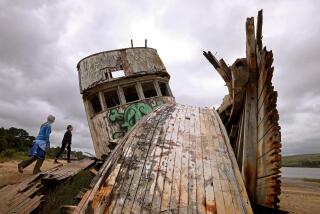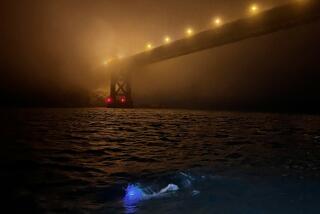Winded Mariner Catches Her Breath in Falklands
Nearly two months after setting sail from Tahiti, the last three weeks of which were spent being tossed like a cork on 20-foot seas whipped by 40-knot winds, Karen Thorndike safely pulled into the harbor at Stanley on East Island of the Falklands chain late Tuesday.
Two days later, still a little wobbly but otherwise OK, she was asked how much fun it is trying to become the first American woman to sail solo around the world.
“I can’t begin to tell you how relieved I am to get in here, and to have found a secure area for my boat,” she said in a brief telephone interview. “They should hold windsurfing contests here. It’s blowing 35 knots.”
If wind is a sailor’s best friend, Thorndike, 54, a Seattle resident whose journey aboard the 36-foot Amelia began Aug. 4 in San Diego, has had quite a pal on this, the fourth leg of a global circumnavigation that is expected to end in July.
It was the wind that kept her awake for most of every day as she sailed through the treacherous waters off Cape Horn--the southernmost point of the South American continent.
It was the wind that nearly knocked her overboard on several occasions as she went aft to deal with her mainsail.
It was the wind, or gale, that blew her vessel back out to sea just as she passed the lighthouse entering the harbor, forcing her to tack her way back “inch by inch” for several hours.
But without the wind she wouldn’t have made it as far as she has, so she’s not complaining--much.
“I got very little sleep, about four hours a day for what seemed like forever,” she said. “There was just so much to do, especially close to the Cape. The water was just so incredibly rough, and the squalls were constant and the motion of the boat . . . was so extreme that I couldn’t get any sleep no matter how tired I was. About the only thing I experienced along the way was extreme fatigue. Fortunately, adrenaline kicks in with fear.”
Fatigue might explain the invisible stranger who paid her a visit one day as she was approaching the Cape.
“It was at a time when there wasn’t any heavy weather, but I swear I felt the presence of someone else on the boat,” she said. “It was so strong, I opened the hatch and quickly turned around because I thought someone was there. I don’t even believe in these things, but this was . . . very unsettling.”
After leaving Tahiti on Nov. 18, Thorndike didn’t see so much as another boat until the other day, when she was dwarfed by the 200-foot yacht Adix, which was also headed to Port Stanley.
She met the crew inside the harbor and was offered what she missed and wanted the most, a hot shower.
Thorndike plans to spend the next two weeks eating well and getting in some serious snooze time before setting a course for Perth, Australia. From there she will sail to Hilo, Hawaii, and from Hawaii back to San Diego.
After that, she probably will have had enough of the wind.
*
Add Thorndike: Thanks to modern technology, she is able to maintain regular communication with her home base and transmit progress reports via e-mail and photographs via satellite.
Those wanting to follow her journey may do so by visiting https://www.goals.com on the Internet.
THE RIVER WILD
Those with a favorite fishing hole on the West Walker River near Bridgeport may have trouble finding it when the season opens this spring, thanks to torrential rains that kicked off the new year.
So violent was the flood in Walker Canyon, from the beginning of the Sonora Pass north to Topaz, that the river swelled beyond its banks, carved a new channel in the landscape and washed away a 10-mile stretch of pavement on U.S. 395 just north of Bridgeport.
Mono County engineers say the popular route to the Lake Tahoe-Reno area will remain closed until at least late summer. They point out, however, that an alternate route does exist for northbound travelers, who now must detour via California 182 in Bridgeport and enter Nevada before reentering California on U.S. 395 near Topaz Lake.
As for the prized trout fishery on the West Walker, Department of Fish and Game biologists are still working to assess the situation.
Meanwhile, several agencies will have their hands full, not only repairing U.S. 395 but getting the river back into its original channel, which runs adjacent to the highway before emptying into Topaz Lake.
WEATHER-BEATEN
Bay Area crab fishermen are blaming Mother Nature for a disastrous start of their season and some believe the rain and runoff are at least partly responsible for extremely poor fishing.
In the days before the opener in mid-November, a 40-foot trawler sank near San Francisco while carrying traps to the fishing grounds. Its crew of three was rescued by the Coast Guard. A few days later, two men were lost at sea and presumed drowned when their vessel was inundated and sunk by 17-foot seas just north of the Golden Gate. A third crewman managed to swim to shore.
In December, another vessel sank in heavy seas near the mouth of the Klamath River. Two men were rescued, but a third was presumed drowned.
Ron Warner, a DFG biologist, told National Fisherman, a commercial fishing publication, that since 80% of the season’s catch is usually landed in the first month, “guys go fishing in horrible weather, desperate to make those early landings.”
Landings have been mostly meager, with most skippers reporting catches of only two to six Dungeness crabs per pot, compared to the usual 10 to 15. Nobody is sure why, but some are guessing that rough weather has the crabs buried in the sand. Others say this is merely the start of a slow cycle.
BAJA BITE
Panga skipper Oswaldo “Ozzie” Marquez, one of the few Cabo San Lucas captains to have a “grander,” or 1,000-pound marlin to his credit, was involved in a battle the other day with another giant billfish, except this one was missing its bill. The blue marlin, estimated at 13 feet long and 700-800 pounds, chomped down on a yellow and green lure just outside the marina and took Marquez and two British anglers for a seven-hour ride 25 miles out before it could be brought alongside the skiff, where it was promptly cut loose.
A few smaller blues were caught in the last week, which is unusual for this time of year, but then this is not turning out to be a typical year. Striped marlin, for example, have left the Pacific and are biting almost exclusively in the gulf at the outer Gordo Bank. Dorado are being caught only sporadically, but plenty of yellowfin remain.
Tuna were cooperating for anglers aboard the San Diego-based Polaris Supreme on a recent trip to the Revillagigedo Islands south of Baja, but the sharks were not.
“Our trip could have been excellent except for the sharks,” skipper Tommy Rothery said. “They ate 50% of our fish outright. They were nauseating.”
Perhaps, but 18 anglers still managed to boat 83 yellowfin.
More to Read
Sign up for The Wild
We’ll help you find the best places to hike, bike and run, as well as the perfect silent spots for meditation and yoga.
You may occasionally receive promotional content from the Los Angeles Times.






